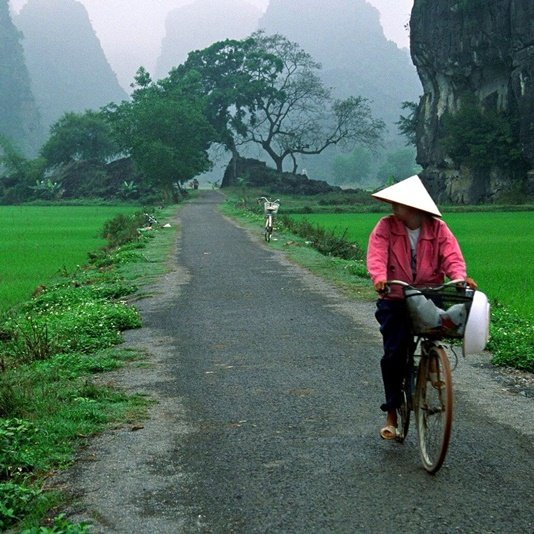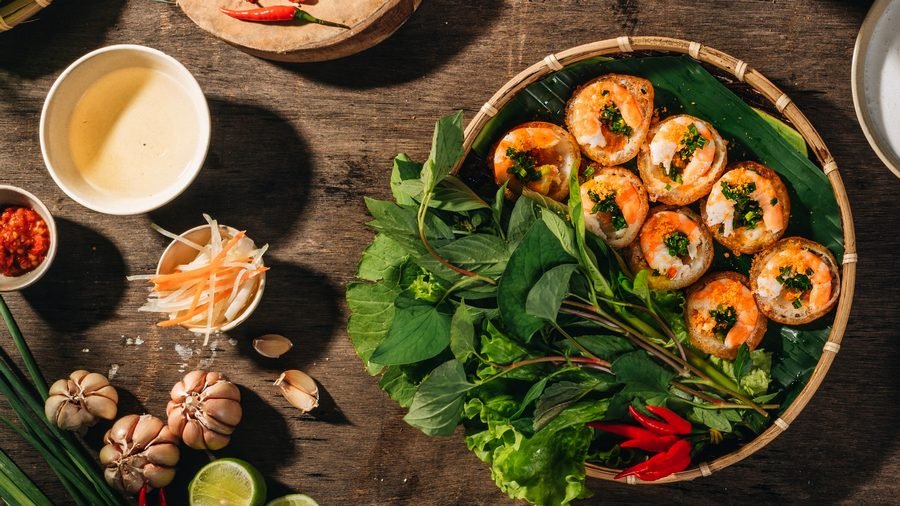Việt Nam is the easternmost country on the Indochina Peninsula in Southeast Asia. It is bordered by China to the north, Laos to the northwest, Cambodia to the southwest, and the East Sea to the east.
- Land area: 331,688 km²
- Population: 90 million
- Time: GMT+7
- Currency: Vietnamese dong (VND)
Geography
Three quarters of Vietnam’s territory consists of mountains and hills with two major delta plains silted by the Red River in the north and the Mekong River in the south. The Red River Delta stretches for 15,000 sq.km. Over time, deposits of alluvium carried from the Red River and Thai Binh River have accumulated to form the delta. The ancient Viet people settled at the junction of the two rivers . At that time, the wet rice civilization was established. The Mekong River Delta is approximately 40,000 sq. km. The land is very fertile and has favorable climate conditions for agriculture. As a result, it is the largest rice growing region in Vietnam.
The coastal line
Vietnam’s coastline is 3,260 km long. If you have a chance to travel along the coast of Vietnam, you will be able to enjoy the beautiful beaches of Tra Co, Sam Son, Lang Co, Non Nuoc, Nha Trang, Vung Tau, and Ha Tien. In some places, you will see mountains jutting out to the sea. One such magnificent site is Halong Bay, which has recently been two times listed as a World Heritage Site by the UNESCO.
National parks
The forests of Vietnam account for most of the total land area. National parks are preserved by the state and follow a steady development plan. Some of the more famous national parks located throughout the country include Ba Vi in Ha Tay, Cat Ba in Haiphong, Cuc Phuong in Ninh Binh, Bach Ma in Hue, Cat Tien in Dong Nai.
Climate
Vietnam is located in both a tropical and a temperate zone. It is characterized by strong monsoon influences, but has a considerable amount of sun, a high rate of rainfall, and high humidity. Regions located near the tropics and in the mountainous regions are endowed with a temperate climate. The annual average temperature ranges from 22ºC to 27ºC. In Hanoi, the average temperature is 23ºC, in Ho Chi Minh City it is 26ºC, and in Hue it is 25ºC.
Culture
Language
Vietnamese, the official language, is spoken by the majority of the population (see Austro-Asiatic Languages). The use of French, a remnant of colonial times, is declining. Some Vietnamese people who live in urban areas speak other languages, such as English and Russian. Khmer, Montagnard, and Cham are spoken primarily in the interior.
The society
Kinship plays an important role Vietnam. Unlike Western culture’s emphasis on individualism, Eastern culture values the roles of family and clanship. Comparing with Eastern cultures, Chinese culture values family over clan while Vietnamese culture values clan over family. Each clan has a patriarch, clan altar, and death commemorations attended by the whole clan.Most inhabitants are related by blood.
Marriage
In the past, both men and women were expected to be married at young ages. Marriages were generally arranged by the parents and extended family, with the children having limited say in the matter.
In modern Vietnam, this has changed completely as people choose their own marriage partners based on love, and in consideration primarily to their own needs and wants.
Religion and Philosophy
Religion in Vietnam has historically been largely defined by the East Asian mix of Buddhism, Confucianism, and Taoism. They are the so-called Tam Giáo, or “triple religion.” Today it has become more diverse including other religions such as Catholicism, etc. Vietnamese Buddhism has typically been the most popular. This fits perfectly with the “triple religion” concept, making it difficult for many Vietnamese to identify exactly which religion they practice
Besides the “triple religion,” Vietnamese life was also profoundly influenced by the practice of ancestor worship as well as native animism. Most Vietnamese people, regardless of religious denomination, practice ancestor worship and have an ancestor altar at their home or business, a testament to the emphasis Vietnamese culture places on filial duty.
Cuisine
Vietnamese cuisine is extremely diverse, often divided into three main categories, each pertaining to Vietnam’s three main regions (north, central and south). It uses very little oil and many vegetables, and is mainly based on rice, soy sauce, and fish sauce. Its characteristic flavors are sweet (sugar), spicy (serrano peppers), sour (lime), nuoc mam (fish sauce), and flavored by a variety of mint and basil.
Clothing
The most popular and widely-recognized Vietnamese national costume is the Áo Dài. Áo Dài was once worn by both genders but today it is worn mainly by females, except for certain important traditional culture-related occasions where some men do wear it. Áo Dài is derived from the Chinese Qipao, although it consists of a long gown with a slit on both sides, worn over cotton or silk trousers. Áo Dài is elegant and comfortable to wear. Áo Dài was likely derived in the 18th century or in the royal court of Hue. White Áo dài is the required uniform for girls in many high schools across Vietnam. Some female office workers (e.g. receptionists, secretaries, tour guides) are also required to wear Áo Dài.
In daily life, the traditional Vietnamese styles are now replaced by Western styles. Traditional clothing is worn instead on special occasions, with the exception of the white Áo Dài commonly seen with high school girls in Vietnam.
Music
Vietnam has got some 50 national music instruments, in which the set of percussion instruments is the most popular, diverse and long-lasting such as trong dong (copper drums), cong chieng (gongs), dan da (lithophone), dan to rung… The set of blowing instruments is represented by flutes and pan-pipes, while the set of string instruments is specified by dan bau and dan day.
The Vietnamese folksongs are rich in forms and melodies of regions across the country, ranging from ngâm thơ (reciting poems), hát ru (lullaby), hò (chanty) to hát quan họ, trong quan, xoan, dum, ví giặm, ca Huế, bài chòi, ly. Apart from this, there are also other forms like hát xẩm, chầu văn, and ca trù.
Theater
Water Puppetry is a distinct Vietnamese art which had its origins in the 10th century. In Water Puppetry a split-bamboo screen obscures puppets which stand in water, and are manipulated using long poles hidden beneath the water. Epic story lines are played out with many different puppets, often using traditional scenes of Vietnamese life. The puppets are made from quality wood, such as the South East Asian Jackfruit tree. Each puppet is carefully carved, and then painted with numerous successive layers of paint to protect the puppets.
Despite nearly dying out in the 20th century, Water Puppetry has been recognised by the Vietnamese Government as an important part of Vietnam’s cultural heritage. Today, puppetry is commonly performed by professional puppeteers, who typically are taught by their elders in rural areas of Vietnam. It is now extremely popular with tourists, and is performed at the National Museum in Ho Chi Minh city and in specialist theatres. In 2007 a Water Puppet troupe toured the USA to acclaim.




